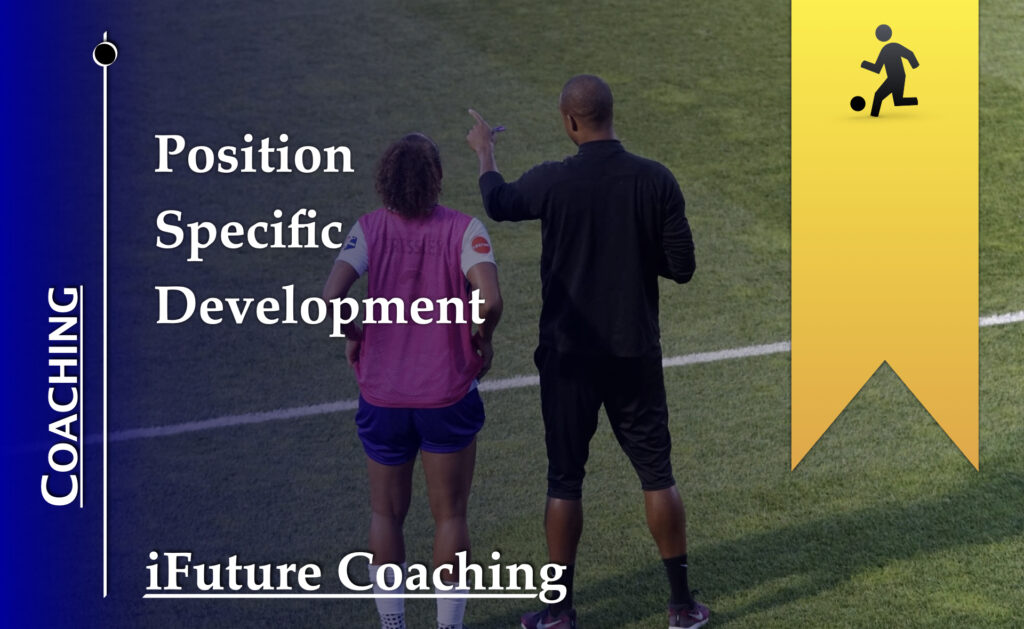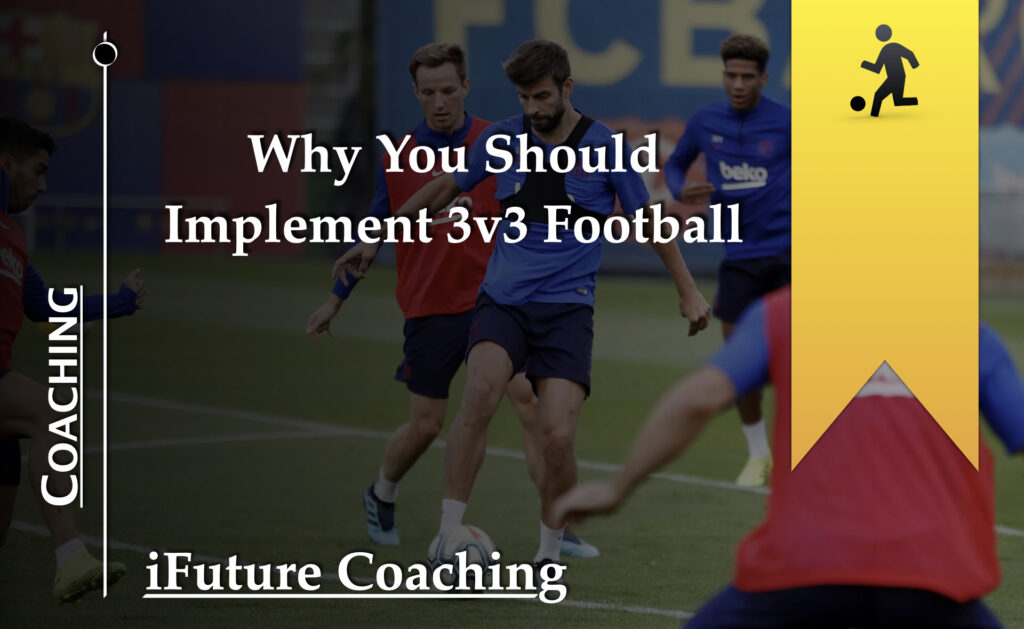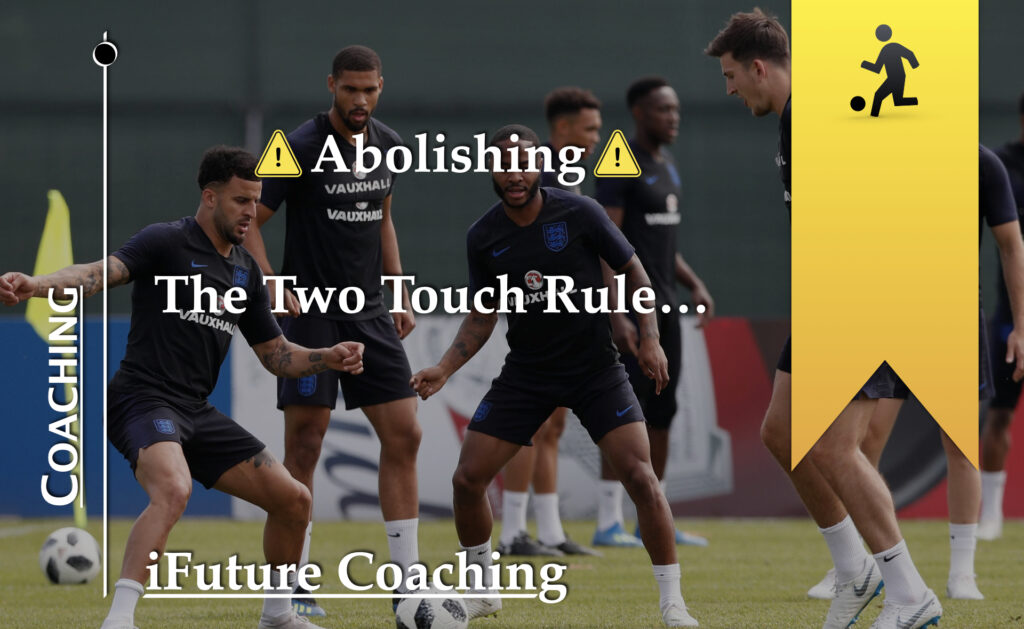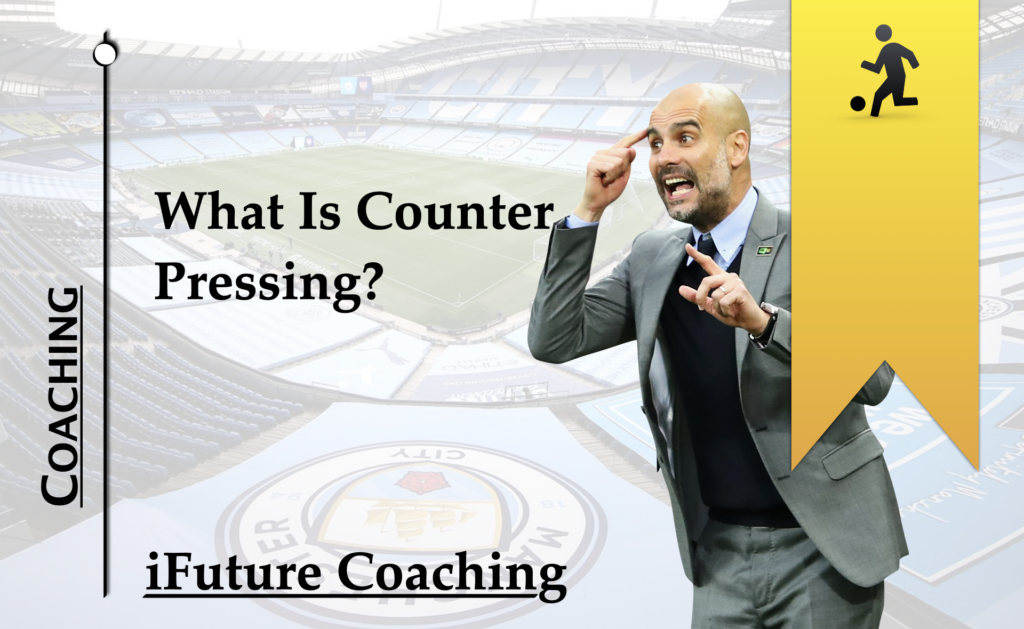Pass and Rotation Play
This session is great for developing angles and back foot receiving skills. Each player will be able to build up on their technical and tactical skills.
The session starts by playing into the central player who then plays outside, the ball then travels around the outside till it gets to the opposite side who repeats going inside once again and back to the start. Each player will need to follow their pass afterwards so that they get to work on different angles and situations.
This works well as a constant and random session so that the players have both repetition of random angles.

This session will develop the following areas:
- Change the direction after a few rounds to develop both sides of the players game
- Add in goals at the end to finish into
You can progress the following ways:
- Change the direction after a few rounds to develop both sides of the players game
- Add in goals at the end to finish into
Session Plan Download Here: Pass and Rotation Play
Sharks Tail
This session is great for developing the foundations of dribbling, ball manipulation, creativity and competition.
The session starts off by the players trying to get from one “dessert island” to another without the sharks catching them. Once they get across they collect a cone (food) and bring it back to their home. This continues until all cones have been accounted for or till the shark has captured all the humans.

This session will develop the following areas:
- Dribbling / Ball Manipulation
- Decision making (when to attack / when to protect)
- Turning & Skills
Things to consider:
- Have a story for the player to imagine they are in so that they will understand the challenges they are facing… “You are on a desert island and need to get food from the other island, be aware of the sharks”
Session Plan Download Here: Sharks Tail Session Plan
Phase 1: Build The Attack
Building up the attack refers to the tactical approach of gradually progressing the ball forward with the aim of creating scoring opportunities. It involves strategically organising players and developing a methodical plan to advance the ball from the defensive zone towards the opponent’s goal.
Building up the attack involves several key elements, such as:
1. Possession: Emphasizing ball control and maintaining possession of the ball by passing and maintaining good spatial awareness.
2. Movement: Encouraging players to make intelligent movements off the ball, including runs, positioning, and creating passing options to generate space and penetrate the opponent’s defence.
3. Transition: Implementing quick transition plays from defence to offense to catch the opponents off guard and exploit any defensive vulnerabilities.
4. Support: Promoting effective communication and coordination among players to provide passing options and support for the ball carrier.
5. Progression: Gradually advancing the ball forward with purpose, often starting from the goalkeeper or defenders, involving midfielders and forwards to push into the opponent’s territory.
6. Creativity: Encouraging players to think creatively and use their individual skills to unlock the defence, incorporating techniques such as dribbling, combination plays, and exploiting spaces.
7. Exploiting weaknesses: Identifying and targeting weaknesses in the opponent’s defensive structure to create scoring opportunities.
Key Principles
– Make the pitch big
– Width, depth, length
– Body shape to receive (open – 1/2 turn)
– Different lines
– Triangles & Diamonds
– Rotations
– Option A, B, & C
– Drive or pass
– Type of pass
– Ball protection
– Forward passing
– Switching play
– Types of turns
Warm Up (10 Minutes)
Physiological Warm Up
Information Coming Soon…
Technical Practice (20 Minutes)
Switching Play - Technical Practice
This session helps support your principles of switching play under pressure and through evolving decision making.
The session starts by the central players dropping off the mannequins receiving on the back foot and switching play. The central defender will look at putting pressure on the passing lines and create questions for the yellow team to solve.
Possession Based Practice 1 (20 Minutes)
Playing Out From The Back
This phase of play helps players understand their movements to receive when playing out from the back. Due to the tempo of the session it helps support the players understanding on where and why their movements link in to one another
The session will start with a ball being played into the goalkeeper, on this trigger the centre backs will split and drop into specific pockets whilst the fullbacks stretch the pitch and provide width and height whilst the 4, 8 and 10 will rotate to find gaps and triangles to help the team play out.
Possession Based Practice 2 (20 Minutes)
3, 2, 1 Possession
This session develops the teams ability to build up and support play effectively. The ball will always start from the Goalkeepers; in the defensive third the team will need to complete 3 passes before moving forward, once in the middle third 2 passes before going into the final third, once there the team have to create 1 pass prior to finishing. If the ball is won in a different zone the team will only look to go forward rather than going backwards.
This Small Sided possession game helps develop all areas of your teams principles and over time will help support a possession based focus. Challenge the players to focus on the different angles to create to play forward on the last pass. Body shape and angles will be key to playing forward quickly and effectively.
Game Related Practice (20 Minutes)
Reverse Goal Game
This session looks to develop the ability to maintain possession and looking to break lines. Both session acts as a normal game with the difference of having the goals back to back. Incorporating an offside rule in, the teams will need to maintain possession whilst breaking through the opposition and scoring. This session naturally loses the attitude of players just hitting the ball long, timing of runs and pass detail will be vital for success in this session.
Ball will start from the goalkeeper each time who can play either short or through into the oppositions half. Breaking the offside trap will be important for each team to progress.
Further Reading
Phase 3: Begin The Attack
Pressing, refers to the tactic of putting pressure on the opponent who has possession of the ball in order to disrupt their ability to play effectively. The main objective of pressing is to regain possession of the ball quickly or force the opponent to make mistakes.
When defending, the pressing players aim to deny time and space to the opponent with the ball, limiting their options and increasing the chances of an interception or mistake. This involves applying pressure by closing down the opponent quickly, engaging in challenges, and blocking passing lanes. The pressing tactic can be executed in different ways depending on the team’s game plan. Some common pressing strategies include:
1. High Press: This involves pushing the defensive line higher up the field and putting pressure on the opponent near their own goal. The goal is to prevent them from playing out from the back and force them into making mistakes or long balls.
2. Midfield Press: The pressing is focused on the midfield area, with players aiming to disrupt the opponent’s passing game and intercept the ball in the central areas of the field.
3. Low Block Press: In this strategy, the defending team drops back and forms a compact defensive shape, narrowing the available space for the opponent. The team aims to press and intercept in their own half, limiting the attacking team’s options in the final third.
Pressing requires good anticipation, coordination, and timing from the defending team, as it can be physically demanding and mentally challenging. It is crucial for players to communicate effectively, maintain discipline, and make collective decisions when executing a pressing strategy.
Key Principles
– Angle of approach
– Body shape
– Set traps
– Overload with out the ball
– Distances/Compactness
– Starting position
– Communication
– Triggers
– Regain in 3-6 seconds
– Primary & Secondary pressure
– Organising behind the ball/ Lock in / Lock on
– Screening/ Rotation
– Press/ Cover/ Balance
– Recovery into shape
Warm Up (10 Minutes)
Physiological Warm Up
Information Coming Soon…
Technical Practice (20 Minutes)
Double Diamond Passing
This session is excellent for building up confidence and quality on receiving on the back foot and playing forward. The balls starts by being played in the same direction on the outside of the session, each player needs to pull away from the mannequins prior to receiving, once the ball has been passed on they follow and set up once again.
Possession Based Practice 1 (20 Minutes)
Three Team Press
This excellent session works several areas across the playing philosophy including; Phase 1 begin the Attack & Phase 3 Begin the Press. The red team and green team will need to keep possession of the ball away from the yellow team. Each team has unlimited touches prior to passing across the area, forcing the supporting team to set up quicker on transition. Once the defending team wins possession of the ball they then transfer it quickly and swap with the team that just lost creating a transition environment.
Only 2 players are allowed to press at any time, providing primary pressure and secondary pressure units. Middle are will concentrate on blocking the passing lines once the first pressure line has advanced. If the ball get’s passed through then the same occurs once again though roles now change over (closets player presses).
Possession Based Practice 2 (20 Minutes)
Advanced Three Team Press
This session is perfect for the final advancement of the technical 3 Team press. It helps incorporate realistic movements for players playing in the 11 aside game.
The session starts by the goalkeeper playing the ball to one of the in possession teams signalling the defenders to be press. In this practice the Blue team will start keeping possession and looking to play through the central area (along the ground) to the opposite Red team. The Yellow team can send 3 players into the attacking zone to win the ball back, whilst the other 3 players provide secondary pressure and intercept and back up the pressing team.
When the ball has been regained, the pressing team must score for the teams to rotate.
Game Related Practice (20 Minutes)
3, 2, 1 Possession Game
This session develops the teams ability to build up and support play effectively. The ball will always start from the Goalkeepers; in the defensive third the team will need to complete 3 passes before moving forward, once in the middle third 2 passes before going into the final third, once there the team have to create 1 pass prior to finishing. If the ball is won in a different zone the team will only look to go forward rather than going backwards.
This Small Sided possession game helps develop all areas of your teams principles and over time will help support a possession based focus. Challenge the players to focus on the different angles to create to play forward on the last pass. Body shape and angles will be key to playing forward quickly and effectively.
Further Reading
Phase 2: Finish The Attack
Attacking, in the context of coaching football, refers to the strategies and techniques employed by a team to score goals against the opposing team. It involves creating scoring opportunities, using effective passing and dribbling, making runs into space, and taking shots on goal.
Attacking also involves coordination and teamwork among the players to break down the opposition’s defence and create scoring chances.
Key Principles
– Types of pass
– Weight of pass
– Passing disguise
– Movements, speed, and timing of runs
– Variety of runs
– Types of Finishing
– Combinations (1-2’s)
– Overlaps/Underlaps
– 3rd Man Runs’s
– Penetration
– Types of movements
– Decision Making (Shots/ Crosses)
Warm Up (10 Minutes)
Physiological Warm Up
Information Coming Soon…
Technical Practice (20 Minutes)
Angled Passing & Finishing
This session is great for building up the players understanding of how to move off players to receive and combine with others.
The session starts by the top player playing into the furthest central player who passes either left or right. The ball travels around the outside until it gets to the top corner players who then combine with the deepest central player who receives to finish at goal.
Possession Based Practice 1 (20 Minutes)
Crossing & Finishing Practice
This session is excellent for developing your players ability to deliver effectively from wide areas as well as your strikers ability to finish first time. With the concentration on the teams wide players the strikers development becomes a bi-product.
The session starts with a combination around the deep mannequin. The wide player then runs onto a through ball down the channel and then delivers into the box for the striker to finish. Having an object (mannequin’s or small goals) for the wide player to beat will provide a further realistic challenge.
Possession Based Practice 2 (20 Minutes)
Combination Play
This session helps support the players ability to link in wide areas as well as central play. Encourage the players to play on limited touches and build through, round or over the defence where needed.
The session will always start from the goalkeeper who can distribute to their team mates in any position. Only starting restriction is that the wide channels can only have a 1v1 between the two fullbacks at any time.
Game Related Practice (20 Minutes)
3 Team Game
A great game that covers so many attributes, depending on your principles depends on what you can develop. This will and can all be developed alongside the psychological factors.
You can choose from several different challenges to get the most out of your session, adapt the distances to bring out specific philosophies.
Further Reading
Phase 4: Defend The Goal
Defending refers to the strategies and techniques employed by a team to prevent the opposing team from scoring goals. It involves positioning players strategically, maintaining good communication and coordination among the defensive line, and using various tactics to disrupt the opposition’s attacking play.
Defending typically includes actions such as marking opponents, intercepting passes, tackling, blocking shots, and regaining possession of the ball. Additionally, defensive players must be vigilant in covering spaces and tracking the movements of opposition players to minimize goal-scoring opportunities.
Key Principles
– Blocks, Headers & Clearances
– Height and Distance
– Ball side
– Man & Ball positioning
– Defend the width of the goal
– No Gaps (Compactness)
– Composure & Patience
– Communication
– 4 D’s; Delay, Deny, Dictate, Disrupt
Warm Up (10 Minutes)
Physiological Warm Up
Information Coming Soon…
Technical Practice (20 Minutes)
Switching Play - Technical Practice
This session helps support your principles of switching play under pressure and through evolving decision making.
The session starts by the central players dropping off the mannequins receiving on the back foot and switching play. The central defender will look at putting pressure on the passing lines and create questions for the yellow team to solve.
Possession Based Practice 1 (20 Minutes)
When To Press - When To Protect
Red team will start by keeping the ball and using the outside green players effectively. They then will look at ways of breaking the lines of the defence and findings ways of penetrating the central area. Start with the green players unable to be tackled then progress to apply more realistic pressure on the ball.
If the Yellow team win the ball then then become the attacking side and link in with the Green’s to dominate against the Red’s. Adding in a competition element will increase intensity and put the players under more realistic pressure.
Possession Based Practice 2 (20 Minutes)
Defending Centrally
This session is great for developing your players ability to be compact and dominate centrally. The red team starts with the ball from the goalkeeper and looks to play through the central area to score their point.
The defending team will stay compact and look to win the ball back. Once gained they then can score in any of the 6 goals, with restrictions:
- Mini Goal: 1 Touch Finish
- Main Goal: Any Touch
Game Related Practice (20 Minutes)
Alternative Reverse Goal Game
This session looks to develop the ability to maintain possession and controlling the game. The in possession team will always start with the ball and look to score in the mini central goals whereas the out of possession team will look to stop them, regain possession and score in the main goals.
You can either transfer who starts on transition of the ball or on a time constraint. Consider which principles are vital for your sides development and adapt accordingly.
Further Reading
Embracing the Player-Centred Approach:
Revolutionising Football Coaching
When it comes to coaching football, the traditional top-down coaching model has dominated the landscape for years. However, a paradigm shift has taken place, placing emphasis on a player-centred approach. This new coaching methodology focuses on placing the players at the centre of the coaching process, empowering them to take ownership of their development and fostering a nurturing environment where they thrive. We will delve into what exactly constitutes a player-centred approach in football coaching and discuss its benefits in enhancing player performance and overall team dynamics.

Understanding the Player-Centred Approach:
The player-centred approach in football coaching is about creating an environment where players can explore, experiment, and take responsibility for their own development. Unlike the traditional coach-centred approach, which involves the coach dictating training sessions and strategy, the player-centred approach seeks to empower athletes to become actively engaged in their own learning process.
Key Principles:
1. Indvidiualised Development:
The player-centred approach acknowledges that each player possesses unique strengths, weaknesses, and learning styles. Coaches who adopt this approach tailor their coaching methods to meet the specific needs of each player, maximising their potential.
Individualised development also allows coaches to pay closer attention to the specific needs and conditions of each player. By carefully analysing players’ strengths and weaknesses, coaches can design training sessions and provide targeted instruction to address individual areas of improvement. This tailored approach helps players overcome obstacles and refine specific skills, leading to more consistent and effective performances on the pitch.
Each player has a unique trajectory and potential. In a team-focused approach, there is a risk of neglecting individual needs, leaving players unable to reach their full capabilities. Individualised development, on the other hand, allows for a more nuanced and customised approach to enhance player growth. By recognising and promoting the strengths of each player, coaches can cultivate a better understanding of their personal goals and aspirations. This results in a higher level of motivation and commitment from players, leading to improved performance individually and within the team.
Players who receive individualised development experiences tend to have higher levels of confidence and resilience. When players see their coaches investing in their personal development, they feel valued as individuals and gain trust in the coaching process. This increased confidence enables players to take risks, experiment, and explore innovative tactics confidently, which can significantly impact their performance and decision-making on the field. Additionally, the focus on individual progress fosters resilience, as players are encouraged to face and overcome challenges, develop coping strategies, and learn from their mistakes.
By adopting an individualised development approach, coaches can foster a positive learning culture within the team. Players observe personalised attention and recognise the value of continuous improvement. This individual focus inspires a sense of healthy competition among players, promoting peer learning and collaboration. Moreover, players become more self-aware, actively seeking feedback to improve their performance. A learning culture enhances the overall team dynamic and facilitates the development of well-rounded players who can adapt to different situations effectively.
Individualised development is crucial in football coaching as it tailors training methods, attention, and feedback to address the individual needs of players. By embracing this approach, coaches not only fine-tune their players’ technical and tactical abilities but also nurture their confidence, resilience, and motivation. Furthermore, individualised development cultivates a learning culture where players embrace continuous improvement, propelling the team towards success. In the dynamic world of football, recognising and supporting individual potential is the key to achieving excellence in both individual performances and team success.
2. Active Participation:
Players are encouraged to actively contribute to the decision-making process, both individually and collectively. By fostering an open dialogue, players are empowered to voice their ideas, suggestions, and concerns, resulting in a collaborative environment that encourages personal and team growth.
Active participation in football coaching is paramount for the overall growth and development of both individual players and the team. Coaches play a central role in shaping young athletes, providing guidance, motivation, and imparting essential skills. This essay will outline why active participation is crucial in football coaching and discuss its implications on player development, team dynamics, and overall success.
Active participation by coaches during training sessions and matches fosters an environment that promotes motivation and skill development. When coaches actively engage in training activities, they can provide real-time feedback, correct errors, and motivate players to push their limits. Moreover, active participation allows coaches to identify individual players’ strengths and weaknesses, thereby tailoring training sessions to enhance their skills effectively.
Active participation by coaches leads to enhanced communication between the players and the coaching staff. Effective communication is vital in football, as players need to understand and execute various strategies, tactics, and game plans. By actively participating, coaches can effectively convey their ideas, explain the rationale behind specific tactics, and clarify players’ roles and responsibilities, thereby ensuring everyone is on the same page.
Football coaches play a crucial role in mentoring and shaping players’ character, on and off the field. By actively participating, coaches become mentors, offering guidance, support, and imparting life skills to young athletes. They have the opportunity to instil virtues such as resilience, perseverance, teamwork, and humility. Active participation allows coaches to build strong connections, earn players’ trust, and have a positive influence on their personal development beyond the game of football.
Active participation in football coaching is vital for player development, team dynamics, and overall success. By actively engaging in training activities and matches, coaches can motivate players, enhance skill development, improve communication, and build strong team dynamics. Moreover, they can set high standards of discipline and mentor players’ personal development. It is through the active involvement of coaches that athletes can reach their full potential and achieve excellence both on and off the pitch, making active participation an indispensable aspect of football coaching.
3. Skill Acquisition through Decision-Making:
The player-centred approach emphasises decision-making as a vital skill to develop in footballers. Coaches encourage players to make their own decisions during training exercises and matches, allowing them to develop their awareness, game intelligence, and problem-solving abilities effectively.
Skill acquisition through decision-making in football coaching is instrumental in developing players’ cognitive abilities. Football is a fast-paced sport where decisions need to be made quickly and accurately. By providing players with opportunities to make decisions during training, coaches enhance their cognitive skills, such as perception, attention, and memory. These cognitive abilities enable players to process complex situations on the field and react effectively.
Having good decision-making skills on the football pitch is synonymous with having excellent game intelligence. Football coaching focused on skill acquisition through decision-making enhances players’ ability to understand the game, anticipate situations, and make intelligent choices. By simulating real-game scenarios in training, coaches provide players with the opportunity to analyse, evaluate, and react under pressure. Ultimately, this results in players who possess superior game intelligence, enabling them to make effective decisions during matches.
Skill acquisition through decision-making empowers players and instils confidence in their own abilities. Making decisions on the field allows players to take ownership of their actions, encouraging them to be proactive and assertive. This sense of responsibility promotes self-confidence and independence, vital qualities for success in football and life beyond the sport. By allowing players to make decisions within a controlled environment, football coaching fosters a growth mindset, where mistakes are viewed as learning opportunities rather than failures.
Skill acquisition through decision-making is of paramount importance in football coaching, as it enhances players’ cognitive abilities, game intelligence, technical skills, confidence, responsibility, teamwork, and communication. By implementing decision-based training sessions, coaches equip players with the necessary tools to excel in the dynamic and unpredictable nature of the game. Ultimately, the ability to make effective decisions under pressure is a critical attribute that separates exceptional players from the rest in the world of football.
4. Individual and Group Reflection:
Reflective practice is an integral aspect of the player-centred approach. Coaches encourage players to analyse their performances critically and identify areas for improvement. Similarly, group reflection promotes collective learning, enabling the team to evolve and adapt collectively.
Individual reflection holds immense value as it allows players to gain self-awareness, analyse their own strengths and weaknesses, and set goals for self-improvement. By encouraging players to reflect on their own performances, coaches enable them to identify areas where they can develop and excel. This process leads to a greater understanding of one’s abilities, cultivating a sense of confidence and self-belief crucial for success on the field. Through self-reflection, players become more accountable for their own growth, fostering a proactive mindset and a desire to continuously improve.
Group reflection plays a pivotal role in the development of team dynamics. Teams that engage in regular reflective discussions learn how to communicate effectively, share insights, and collectively solve problems. By bringing players together to reflect on shared experiences and identify areas for improvement, coaches create a collaborative environment where players learn from one another. Furthermore, promoting open and honest communication within the team enhances trust and cohesion, fostering a supportive and unified atmosphere that translates into improved on-field performance.
Reflective practices heavily influence how players perform during training sessions and matches. By analysing their own actions and decision-making processes on the field, players can identify patterns, assess their effectiveness, and make necessary adjustments. Individual reflection allows players to fine-tune their technical skills, tactical understanding, and decision-making abilities. Group reflection, on the other hand, provides an opportunity for players to collectively analyse team strategies, game plans, and areas where they can collectively improve. The insights gained from these reflective practices guide subsequent training sessions, leading to constant growth and development.
Individual and group reflection serve as powerful tools for learning from both success and failure. When players reflect on successful outcomes, they unpack the reasons behind their achievements, identifying strategies and behaviours that contributed to their performance. This analysis allows them to reinforce effective practices and replicate success in future situations. Likewise, reflecting on failures provides valuable insights into shortcomings and areas for improvement. This process helps players understand what went wrong and develop strategies to rectify mistakes and avoid repeating them in the future.
Individual and group reflection are indispensable components of successful football coaching. By encouraging players to self-reflect and engage in collective analysis, coaches facilitate personal development, teamwork, and improved performance on the field. These practices foster a culture of continuous improvement, where players develop a growth mindset, embody strong team dynamics, and learn from both success and failure. Through reflective practices, players become not just better athletes but also more well-rounded individuals, equipped with the skills necessary for success far beyond the football field.
Benefits of the Player-Centred Approach:
There are several benefits of the player-centred approach that need to be considered when creating your coaching philosophy.
By granting players a sense of ownership over their development, the player-centred approach enhances their motivation and commitment to personal growth. Players become actively engaged, undertaking training sessions with a renewed sense of purpose, leading to enhanced performance and self-belief.
Players exposed to a player-centred coaching environment develop the ability to make informed, timely, and independent decisions on the field. Being provided with numerous opportunities to assess game situations autonomously, players become tactically astute and adaptable, making them formidable competitors.
3. Enhanced Team Dynamics and Communication: A player-centred approach fosters an environment built on mutual trust and respect, allowing players to freely express their thoughts and ideas. This creates stronger team dynamics, improved communication, and greater camaraderie, resulting in a cohesive unit that combats challenges both on and off the pitch.
Adopting a player-centred approach facilitates the development of versatile footballers who continue to evolve throughout their careers. It equips players with the necessary skills for lifelong learning, allowing them to adapt to different styles of play and changes in their careers, thus ensuring sustained success in the game.
In conclusion...
The player-centred approach in football coaching transcends the conventional top-down coaching model, placing the players at the centre of their development. By emphasising individual growth, active participation, decision-making, and reflection, this innovative approach empowers players to take control of their learning process. The player-centred approach fosters an environment that not only enhances individual performance but also cultivates strong team dynamics. As we move forward, embracing this coaching methodology will undoubtedly revolutionise football coaching, leading to the emergence of agile, adaptable, and skilled footballers poised for success.
Author: S. Noakes
Further Reading
The False Nine: A Strategic Evolution in Modern Football
In the realm of football tactics, various innovative and strategic approaches continue to evolve, providing teams with new ways to gain a competitive edge. One such strategy is the employment of a “false nine” position within a team’s formation. Championed by visionary coaches and players alike, the false nine has revolutionised the traditional structure of football and enhanced the attacking prowess of many teams. This breakdown aims to explore the concept of the false nine, its evolution, its impact on the game, and some notable examples of its successful implementation.

Understanding the False Nine:
The term “false nine” refers to a tactical approach in football where a forward player operates as a deep-lying centre forward, dropping back into a playmaker’s role rather than primarily engaging in the attacking line. It involves sacrificing a traditional number nine striker, who typically leads the line, in favour of a more versatile and creative player who can orchestrate the attack from a deeper position.
Evolution and Development:
The origins of the false nine can be traced back to the 1970s, wherein the legendary Dutch striker Johan Cruyff pioneered the concept during his time with Ajax Amsterdam and the Dutch national team. Cruyff’s ability to drop deep and roam the midfield allowed him to create mismatches for opposing defences, breaking traditional defensive lines and confusing markers.
The Influence of Lionel Messi:
The term “false nine” gained significant prominence in recent years due to the impact of arguably the greatest player of this generation – Lionel Messi. Under the guidance of coach Pep Guardiola, Messi showcased the true potential of the false nine position during his time at Barcelona. Guardiola’s tactical setup allowed Messi to drop deep into midfield areas, creating space and causing disarray among defenders.
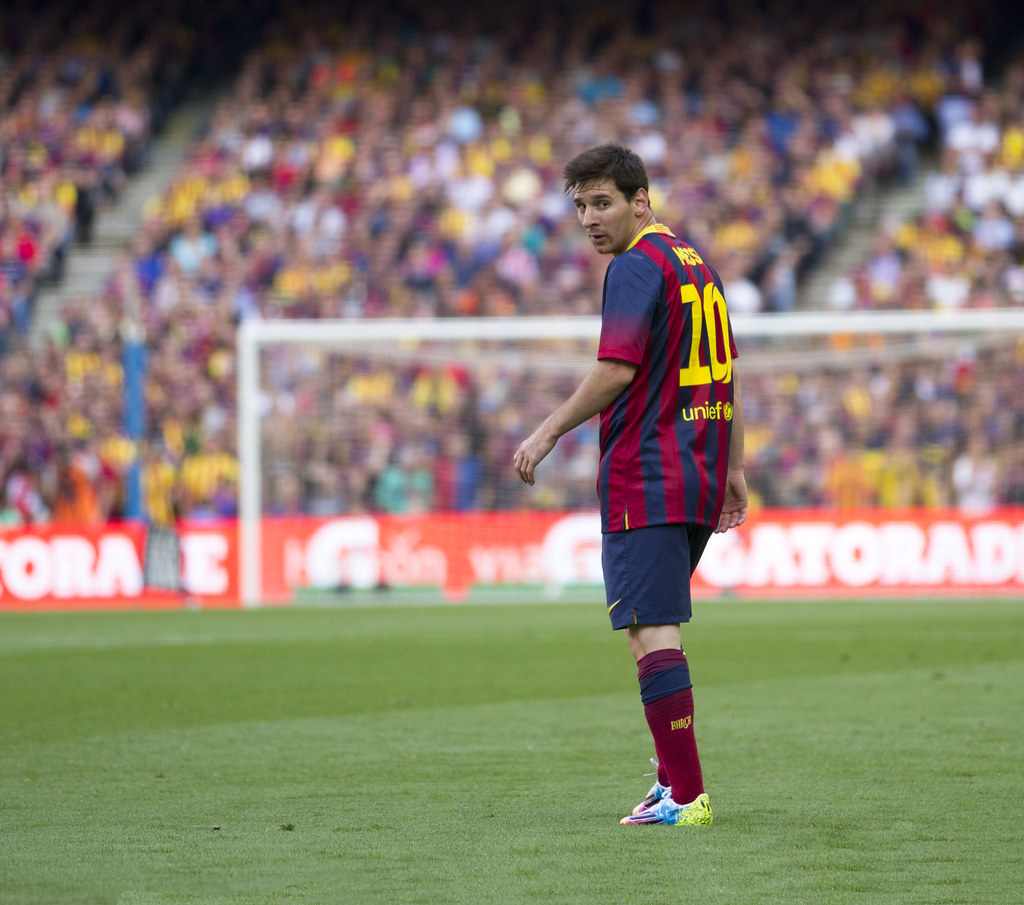
Effects on the game:
The implementation of the false nine has introduced a dynamic attacking approach, granting teams newfound versatility and unpredictability in their play. By having a forward who can both create and score goals, teams can overload midfield areas, disrupt defensive structures, and exploit gaps in the opposition’s lines. Moreover, defences find it challenging to mark a false nine, as they often operate in unconventional spaces, leading to confusion and miscommunication among defenders.
Notable Examples:
Apart from Johan Cruyff and Lionel Messi, the false nine has become a popular tactic used by many modern-day coaches. Zlatan Ibrahimovic was widely deployed in this role during his time at Inter Milan, while Francisco Totti found success in a similar position under Luciano Spalletti at AS Roma. Robert Lewandowski at times operates as a false nine for Bayern Munich, showcasing his versatility and ability to influence the game beyond a traditional striker’s role.
In conclusion...
The emergence of the false nine position has revolutionised football tactics, challenged traditional line-ups and providing teams with a new dimension of attacking prowess. Its strategic implementation creates confusion for defenders, often resulting in unmarked spaces and advantageous situations for the attacking team. While the concept may have originated decades ago with Johan Cruyff, it was Lionel Messi who captivated the footballing world by exploiting the role to its fullest potential. As the game evolves, the false nine position will continue to play a significant role in shaping the outcome of matches, leaving opponents puzzled and coaches eager to harness its advantages.
Author: S. Noakes
Further Reading
Altitude Training: Enhancing Performance on the Field
Altitude training has become an integral part of many professional athletes’ training regimes, including footballers. This blog aims to shed light on what altitude training is and explore why it has gained widespread popularity among football players. By enhancing endurance, strengthening lung capacity, and improving overall performance, altitude training has become an essential tool for footballers looking to gain a competitive edge on the field.

Altitude training involves exposing athletes to reduced levels of oxygen present at high altitudes. This is achieved by training and living at higher elevations, typically above 1,500 meters (4,900 feet) above sea level. The decreased oxygen availability at high elevations stimulates the body to adapt by increasing red blood cell count, improving oxygen transportation, and enhancing aerobic capacity.
Football matches often demand high endurance levels, as players are constantly running, sprinting, and changing directions. Altitude training allows players to train in an environment with lower oxygen concentrations, forcing the body to adapt and improve its oxygen utilization efficiency. As a result, footballers develop better endurance and can sustain high-intensity efforts throughout the duration of a match, ultimately improving their overall performance on the field.
With the respiratory system under strain at high altitudes, altitude training prompts footballers to consciously take deeper breaths and develop stronger respiratory muscles. This increases lung capacity and strengthens the diaphragm, enabling players to intake more oxygen during matches. Enhanced lung function allows footballers to maximize their aerobic capacity, leading to improved stamina and quicker recovery from intense physical exertion.
One of the key advantages of altitude training is its ability to enhance performance even when athletes return to sea level. Footballers who have undergone altitude training possess a higher concentration of red blood cells, enabling them to carry more oxygen to their muscles. This advantage translates into improved performance when competing at lower altitudes, giving altitude-trained footballers an edge over their opponents who have not undergone such training.
Blood doping is a term commonly used in the realm of sports and refers to the practice of enhancing one’s athletic performance by artificially increasing the amount of red blood cells or the oxygen-carrying capacity of the blood. This controversial technique has been in existence for several decades and has been utilized by athletes in various disciplines in the pursuit of gaining a competitive edge. However, blood doping is considered unethical and illegal in most sporting organizations, as it poses significant health risks to those who engage in it. This essay explores the concept of blood doping, its methods, and the potential consequences associated with this performance-enhancing practice.
Methods of Blood Doping:
There are several methods through which athletes engage in blood doping. One common technique involves the injection of erythropoietin (EPO) into the bloodstream. EPO is a hormone naturally produced by the kidneys that stimulates the production of red blood cells. By injecting external sources of EPO, athletes can increase their red blood cell count, leading to enhanced endurance and performance.
Another method of blood doping involves blood transfusions. Athletes may withdraw their blood weeks or months before a competition and store it to be reinfused later. With this technique, the athlete effectively increases the volume of red blood cells in their bloodstream, resulting in improved oxygen delivery to muscles during physical exertion.
Consequences and Risks:
While blood doping may seem appealing for athletes seeking a competitive advantage, it is important to consider the potential consequences associated with this practice. Firstly, blood doping can have serious health risks. When artificially augmenting the amount of red blood cells in the body, the blood becomes thicker and more viscous. This can lead to an increased risk of blood clots, strokes, and heart attacks.
Furthermore, the abuse of blood doping can disrupt the body’s natural regulatory mechanisms, leading to negative side effects. Excessive EPO use, for example, can cause the blood to become too packed with red blood cells, resulting in a condition known as polycythemia. This condition can elevate blood pressure and impair blood flow to vital organs, potentially leading to organ damage or failure.
Ethical and Legal Implications:
Blood doping is not only a health risk but also a violation of ethical standards in sports. The use of performance-enhancing substances undermines fair competition, as it provides an unfair advantage to those who engage in such practices. Athletes should be rewarded based on their natural abilities, training, and dedication, rather than on the use of artificial means to enhance their performance.
Sports organizations and governing bodies take a strong stance against blood doping due to its unethical nature. Various anti-doping agencies have implemented comprehensive testing methods to identify blood-doping substances and techniques. Those found guilty of blood doping can face severe penalties, including disqualification from competitions, loss of titles, suspension, and even bans from participating in sports for extended periods, tarnishing their careers and reputations.
Conclusion:
Blood doping is a performance-enhancing practice that involves artificially increasing the amount of red blood cells or the oxygen-carrying capacity of the blood. While it may offer short-term benefits in enhancing athletic performance, the consequences and risks associated with blood doping are significant. From potential health complications to the ethical implications in sports, blood doping is firmly condemned by sports organizations. Upholding the principles of fair play and maintaining the integrity of sports should be prioritized over achieving temporary success through artificial means.
Altitude training not only strengthens the body but also fosters mental resilience in footballers. Training at high altitudes can be physically demanding and mentally challenging due to the decreased oxygen availability. Overcoming these obstacles helps athletes develop a strong mindset, which is vital for success on the football field. The mental fortitude acquired during altitude training can positively influence players’ confidence levels, decision-making abilities, and focus during high-pressure situations in matches.
Altitude training has increasingly gained popularity among footballers as a means to enhance their performance and physical capabilities. Training in high-altitude environments offers several physiological benefits, including improved oxygen utilisation, increased red blood cell count, and enhanced endurance. Choosing the perfect destination for altitude training is crucial for footballers seeking optimal results. In this essay, we will explore some of the best locations for altitude training and discuss the factors that make them ideal choices for footballers.
Factors to Consider:
When selecting a destination for altitude training, it is essential to consider various factors that can contribute to an effective training experience. Some key factors to consider include altitude levels, infrastructure, climate, accessibility, training facilities, and accommodation options.
1. La Paz, Bolivia:
La Paz, the administrative capital of Bolivia, is often considered one of the premier destinations for altitude training due to its remarkably high altitude. Situated at an elevation of approximately 3,650 meters (11,975 feet) above sea level, the city provides athletes with a significant physiological challenge. La Paz offers a range of training facilities and ample high-altitude accommodation options, providing an environment that caters specifically to athletes’ needs. The city’s climate, with cool and dry summers, accommodates year-round training without extreme weather interruptions.

2. Quito, Ecuador:
Quito, the capital city of Ecuador, is another excellent choice for footballers seeking altitude training. Sitting at an elevation of around 2,850 meters (9,350 feet), Quito provides a moderate altitude that promotes gradual adaptation. The city boasts excellent infrastructure, including quality training facilities and a variety of accommodations. Additionally, Quito’s mild climate, with average temperatures ranging from 50 to 70 degrees Fahrenheit, helps create a comfortable training environment year-round.

3. Cusco, Peru:
Cusco, the historic city nestled in the Peruvian Andes, offers a high-altitude training paradise. Located at an elevation of approximately 3,400 meters (11,200 feet), Cusco provides footballers with an ideal environment for altitude adaptation. The city offers access to world-class sports facilities and training centers, combining professional facilities with breath taking scenery. Accommodation options, ranging from luxury hotels to budget-friendly hostels, cater to athletes of all levels. However, it is worth noting that Cusco experiences more significant temperature fluctuations and occasional rain, requiring additional preparation for training sessions.
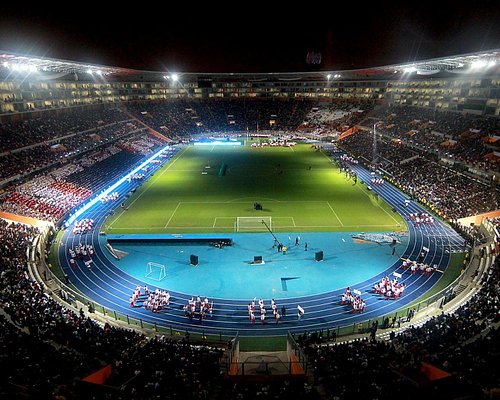
4. Flagstaff, Arizona, United States:
While not at the same altitude level as some international destinations, Flagstaff in Arizona, USA, offers a unique training experience due to its high elevation. Situated at around 2,100 meters (7,000 feet), Flagstaff provides a moderate altitude suitable for gradual adaptation. The city is home to numerous high-performance training centers, including altitude chambers and elite sports facilities. Its well-established sports community and welcoming climate, with mild summers and snowy winters, make Flagstaff an attractive choice for both domestic and international football teams.

In conclusion...
When it comes to altitude training for footballers, careful consideration must be given to choosing the right destination. La Paz, Bolivia, Quito, Ecuador, Cusco, Peru, and Flagstaff, Arizona, are among the top choices due to their varying altitude levels, quality infrastructure, favourable climates, and accessible training facilities. However, it is essential for footballers and their coaching staff to evaluate their specific training goals and adaptability to different altitudes when making a decision. Ultimately, selecting a conducive altitude training destination can significantly contribute to a footballer’s success by improving endurance, oxygen utilisation, and overall physical performance.
Altitude training has become an essential part of many professional footballers’ training programs due to the numerous benefits it offers. By improving endurance, strengthening lung capacity, and promoting mental resilience, altitude training enhances footballers’ overall performance. With its ability to provide a competitive edge on the field, altitude training has proven to be a valuable tool for footballers looking to maximize their potential and succeed at the highest level of the game.
Author: S. Noakes
Further Reading
Analysing the Most Used Formation in Football:
A Tactical Overview
Football, the beautiful game, is known for its tactical intricacies that amalgamate individual skill, team coordination, and strategic planning. Among the various aspects of football, the formation employed by a team plays a crucial role in determining its style of play. Over the years, several formations have emerged and evolved, each with its strengths and weaknesses. This essay aims to delve deep into the question of the most frequently used formation in football, considering its historical significance, tactical advantages, and popularity among successful teams.

Historical Background:
Football formations have undergone significant developments since the game’s inception. Traditional formations, such as the 2-3-5 “pyramid” and the 3-3-4 “WM,” ruled the early days of football. However, the evolution of tactics, coaching methodologies, and player roles paved the way for new formations.
The Modern Era:
In the contemporary game, one formation stands out as the most widely utilized – the 4-3-3 formation. This configuration places four defenders, three midfielders, and three forwards on the pitch. It has seen tremendous success and popularity since its inception, mainly due to its flexibility and adaptability to different playing styles.
Tactical Advantages:
The 4-3-3 formation offers various tactical advantages that make it the go-to choice for many teams. Firstly, its balanced structure provides stability in defence by having two centre-backs flanked by two full-backs. This defensive solidity allows teams to maintain numerical superiority at the back while preventing openings through the central areas.
Moreover, in midfield, three central midfielders operate. One of them typically acts as a holding midfielder, shielding the defence and distributing the ball, while the other two engage in a combination of defensive and offensive duties. This central midfield trio enables effective control of the game, both in terms of ball possession and maintaining compactness.
The attacking trio in a 4-3-3 formation is equally influential. The presence of three forwards ensures constant pressure on opposing defences, creating various attacking options. Wide forwards offer width and pace on the flanks, while a central striker serves as a focal point, holding up play and providing a goal-scoring threat.
Success in Modern Football:
Numerous successful teams around the world have embraced the 4-3-3 formation and achieved remarkable results. Barcelona, under the guidance of Pep Guardiola, garnered immense success employing this formation, with players like Lionel Messi, Xavi, and Andrés Iniesta thriving in their respective roles. Similarly, Liverpool, under Jürgen Klopp, have utilized the 4-3-3 formation to great effect, securing major silverware with their high intensity pressing and dynamic attacking trios.
Popularity Amongst Coaches:
The popularity of the 4-3-3 formation can also be seen in the widespread adoption by many top coaches. The flexibility it offers, combined with a solid defensive foundation and attacking prowess, makes it an attractive choice for teams to showcase their strengths and exploit the opposition’s weaknesses.
Nevertheless, it is crucial to acknowledge that the most used formation in football is subject to change as tactical trends evolve, influenced by the innovations of coaches, individual player skill sets, and match situations.
Throughout the 2019/20 season and the most used formation was the 4231 and the classic 442, whilst the 433 was only used 90 times throughout that season, we saw a big change in usage throughout the 2020/21 season when we saw a major increase in the use of the 433 formation. We also saw an increase with the 3421 and the 352 show a big trend in adapting to a back three.


Conclusion
The 4-3-3 formation has undoubtedly emerged as the most popular and widely used tactic in football due to its tactical advantages and proven success. Its versatility allows teams to adapt to a variety of gameplay styles while maintaining a balanced defensive structure and a potent attacking force. However, it is important to note that the beautiful game’s constant evolution may bring about new formations in the future, adding new dimensions to the tactical landscape of football.
Author: S. Noakes




